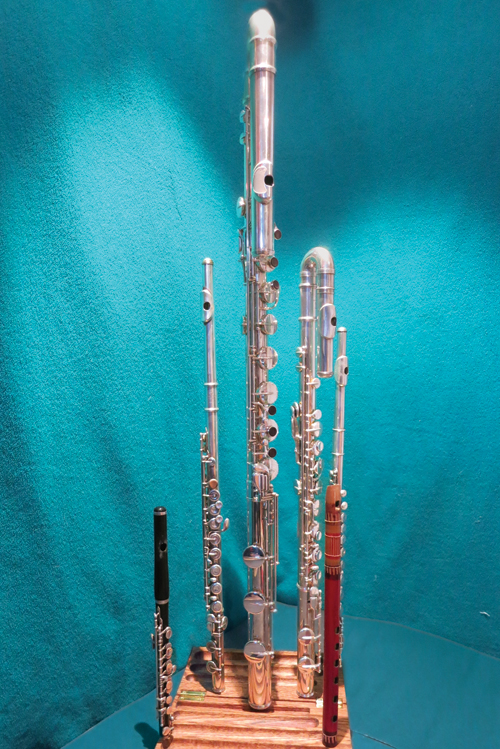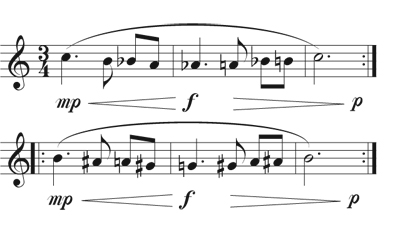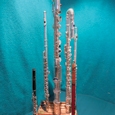
Flute choir members who play multiple flutes confront problems not experienced by those who play just one instrument. These include making quick and accurate embouchure adjustments when changing to another flute, being in tune immediately when picking up a cold instrument, adjusting to the size difference between instruments, transporting multiple flutes and their accessories, and finding lightweight, compact but sturdy portable pegs.
Embouchure
Flutists who switch between piccolo, Eb flute, C flute, alto, bass or contrabass should strive to develop a good consistent sound on all instruments. A weakness on one instrument means it will take longer to adjust when changing from one to another. Developing a consistent tone takes a critical ear and a commitment to high standards. Practice vocalises with a limited number of notes, such as the one below, to assess tone color, evenness of timbre, and fluid vibrato. There is no shortcut to good tone; pay attention to each note. (This exercise is from page 11 of Trevor Wye’s Tone book.)

Continue with this pattern down to the lowest note of the instrument. Practice between quarter note = 54 and 72.
To practice changing between instruments, ask the conductor for the concert order and practice the repertoire in that order one after the other without stopping. This helps identify which instrument is the problem. Pieces that start very low, high, short or soft require a precise setting of the lips. For a piece with one of those troublesome elements right at the beginning, practice that skill separately to focus attention on the problem. Search for etudes that target this skill. Remember scales can be modified to address a particular issue. Once a weak instrument is identified, spend extra time practicing that instrument.
Size Matters
When switching instruments, there can be an odd feeling in the arms and fingers when holding the new larger or smaller instrument. For example, when switching from bass to C flute, the C flute can feel like a toy. Avoid programming a flute piece with a difficult section at the beginning immediately after a bass piece. In a flute choir, pick up the new instrument as quickly as possible. With any luck, the conductor will have something to say about the next piece and there will be a longer adjustment period.
Tuning
Tuning multiple instruments just takes longer and requires some advance planning. Rarely is there time to adjust three instruments well when the entire choir is tuning. Arrive early enough to tune all the instruments in advance and then check them when the whole choir is tuning.
As a rehearsal or concert progresses, many choirs become sharper. In addi- tion, unplayed cold instruments will be flatter than the tuning note, exacerbating the problem. If the first entrance on the new instrument is low and soft, it might sound painfully flat. Work with a tuner to avoid the problem. Check what happens to that particular instrument if is tuned but then sits for a while. Play the soft entrance and check whether the pitch is consistently flat. If it is, anticipate the problem and push in so the first entrance is up to the pitch of the choir. After about 20 seconds of playing, pull back out again if it is too sharp. Be sure to take advantage of rests at the beginning of a piece to blow silently through the new instrument to get it up to performance temperature. Attentive work with the tuner will clarify intonation tendencies. This knowledge offers players a better chance to find the pitch of the choir.
If the intonation is inconsistent when practicing an entrance, work on greater awareness of exactly where the bottom lip is in relation to the embouchure hole and on the consistency of the speed and angle of the air as it leaves the lips.
Transport
Hauling multiple instruments around is tiring and there may be a better option available. A backpack style bag works well for altos and smaller instruments. Consider having a sturdy waist strap added to the bag to take the weight off the shoulders. A rolling suitcase or any bag with wheels can be useful, but stairs are more difficult to navigate. If a bass comes in a case with no handle, strap it onto a rolling suitcase where the rest of the flutes are transported. Wheeled luggage carts are readily available for suitcases whose wheels are inadequate for the job.
For those with contrabasses, a very compact and lightweight case exists that accommodates contras and other flutes, but they are quite expensive. This case does work well if traveling by plane with a contra as it can go into an overhead bin. Most airlines are very accommodating with musical instruments but the bass case may become a personal item.
Pegs
It is easy to find large, heavy bases and sturdy pegs that low flutes can be placed on while practicing at home. It is more difficult to find sturdy, yet lightweight and compact pegs and bases to carry back and forth to rehearsals and performances. Some styles feature fold up legs with rubber feet. These are light and compact for travel, but the legs stick out and can be more easily kicked by errant feet in group setting. Currently there is not a peg for bass flute in this style. Steel bases with interchangeable pegs are sturdy but heavy. Wood pegs and bases are attractive but can also be heavy and bulky. There is also an extremely light and compact wood product that has three screw-in pegs and two small press-in rods. It can be modified to fit five instruments (Picc, Eb, C flute, alto, bass) with a little help from a neighborhood hardware store, a drill and a larger bass peg from a different setup. Search under the accessories category at music stores and online using such terms as flute pegs and flute stands and see what is currently available.
People with woodworking equipment might be persuaded to take on making flute pegs and stands as a project. A person attending my Alto and Bass Retreat made a bass flute stand adapted from a bass clarinet stand that doubles as a way to hold up the end of the bass. Just recently on the Low Flutes Facebook group, a drawing and photo of a simple yet elegant homemade contrabass stand was posted.
Contrabasses frequently come with stands from the instrument maker, but are not always as compact or as light as one would hope. Jonathan Cohen describes how to make a contrabass stand from a camera tripod in the January 2013 Flute Talk issue, page 29. You can also search online for how to make a contrabass flute stand.






